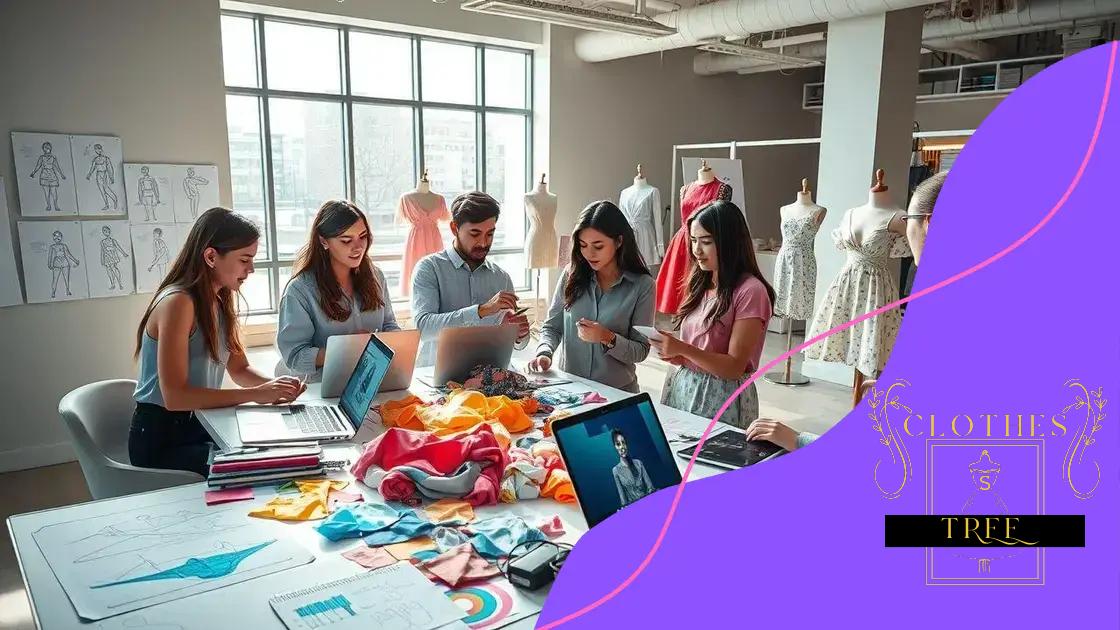Shein’s partnership with fashion universities opens new doors

Shein’s partnership with fashion universities enhances student education by providing real-world project opportunities, access to industry professionals, and insights into sustainable practices, preparing them for careers in the evolving fashion industry.
Shein’s partnership with fashion universities is changing the way students engage with the fashion industry. Have you ever wondered how such collaborations can impact future designers? In this article, let’s dive into the exciting possibilities that arise from this alliance.
Understanding Shein’s strategic objectives
Understanding Shein’s strategic objectives is vital for anyone interested in the fashion industry today. This strategy shapes how the brand interacts with universities and emerging designers.
Shein aims to connect with the next generation of fashion professionals, fostering innovation and creativity.
Key Objectives of Shein’s Strategy
One of the main goals is to enhance brand visibility in the academic world. By establishing partnerships with universities, Shein can gain access to fresh ideas and talent. This collaboration not only benefits the company but also enriches educational programs for students.
- Fostering innovation in fashion design.
- Expanding reach within academic institutions.
- Encouraging sustainable fashion practices among students.
Moreover, Shein’s strategic focus includes supporting student projects that can bring real-world challenges into the classroom. This hands-on experience prepares students for the industry’s demands.
Building Collaborative Networks
Another significant objective is to create a network of professionals. By working alongside students and educators, Shein can cultivate a community that shares knowledge and expertise.
This collaborative approach helps Shein stay ahead of market trends by integrating insights from up-and-coming designers. Overall, understanding these objectives provides a glimpse into how Shein is shaping the future of fashion education.
Benefits for fashion students and universities
The collaboration between Shein and fashion universities brings numerous benefits for both students and educational institutions. This partnership fosters a practical learning environment that enhances the educational experience.
Students engaged with Shein’s initiatives gain firsthand exposure to the fashion industry. They have opportunities to work on real projects that push their creative boundaries.
Enhanced Learning Opportunities
By collaborating with Shein, universities can offer students unique opportunities to learn from industry leaders. This connection enriches their curriculum and prepares students for successful careers.
- Access to workshops led by industry professionals.
- Opportunities for internships that provide hands-on experience.
- Insights into the latest trends and technologies in fashion.
Furthermore, Shein’s partnerships create a dynamic educational atmosphere. Students can participate in challenges that mimic actual business scenarios, thus honing their problem-solving skills.
Promotion of Sustainability
Another significant benefit is the focus on sustainability. Shein encourages students to develop eco-friendly designs and practices during their educational projects.
This commitment to sustainability is crucial in today’s fashion landscape, as it prepares students to address environmental challenges in the industry. Through this partnership, universities can highlight the importance of ethical practices, creating a generation of conscious designers.
Real-world projects and industry collaboration

Real-world projects are a crucial aspect of the collaboration between Shein and fashion universities. These initiatives allow students to apply their skills in practical settings, bridging the gap between theory and practice.
Through these projects, students gain valuable experience that prepares them for the competitive fashion industry. They can work on assignments that mirror real business challenges.
Types of Projects Involved
Students might engage in various projects that include product design, marketing campaigns, and sustainability initiatives. These hands-on experiences foster creativity and innovation.
- Designing fashion lines based on current trends.
- Creating marketing strategies for new products.
- Developing sustainable practices in production.
Additionally, collaboration with Shein provides students access to industry resources and expertise. They can receive feedback from professionals, enhancing their learning experience.
Benefits of Industry Collaboration
Working on real-world projects vastly benefits students. They not only build a portfolio of work but also network with industry professionals. This interaction can lead to future job opportunities.
Furthermore, universities benefit from these collaborations by enhancing their curriculum. Industry insights inform course development, ensuring students are learning relevant skills.
Challenges and criticisms of the partnership
The partnership between Shein and fashion universities brings benefits, but it also faces challenges and criticisms. Understanding these issues is essential for evaluating its overall impact.
One main challenge is the perception of Shein’s fast fashion model. Many believe that this approach encourages unsustainable production practices. Critics argue that prioritizing speed and low costs can harm the environment and labor conditions.
Concerns Over Sustainability
Many students and educators question how Shein can promote sustainability while operating under a fast fashion model. This conflict creates skepticism about the effectiveness of the partnership.
- Potential for promoting disposable fashion trends.
- Environmental impact of rapid production cycles.
- Concerns over ethical labor practices.
Moreover, some universities face pressure to maintain academic integrity while collaborating with a brand like Shein. The fear is that financial ties could influence educational priorities.
Balancing Business and Education
As Shein engages with students, it raises concerns that commercial interests might overshadow educational goals. This creates a tension that universities must navigate carefully.
In addition, the competitive nature of the fashion industry adds complexity. Students often feel the pressure to align with market trends, which can lead to stress and burnout. Balancing creativity with commercial demands is a significant challenge for aspiring designers.
Future of fashion education through partnerships
The future of fashion education is evolving rapidly, especially through partnerships like the one between Shein and universities. These collaborations are reshaping how students learn and engage with the industry.
As fashion trends change, educational institutions must adapt their programs. Partnering with companies like Shein allows schools to incorporate real-world insights into their curriculum.
Incorporating Industry Trends
These partnerships provide students with up-to-date knowledge about current fashion trends and technologies. By attending workshops and guest lectures, students learn directly from industry professionals.
- Access to the latest fashion technologies.
- Exposure to practical skills needed in the marketplace.
- Real-time feedback from experienced designers.
Moreover, as the industry focuses more on sustainability, partnerships can drive awareness and education in this crucial area. Students can work on projects that emphasize eco-friendly practices, preparing them for a more conscious market.
Creating a Diverse Skill Set
Partnerships also help students develop a diverse set of skills that go beyond traditional fashion design. They learn about marketing, business strategies, and sustainable practices that are essential in today’s market.
These broad experiences create versatile graduates who can adapt to various roles within the fashion industry. The collaboration between academia and industry equips students for a successful career in a dynamic field.
FAQ – Frequently Asked Questions about Shein’s Partnership with Fashion Universities
What benefits do students gain from Shein’s partnership with universities?
Students gain hands-on experience, access to industry experts, and the opportunity to work on real-world projects.
What are the sustainability concerns related to fast fashion?
Fast fashion practices can lead to environmental harm and ethical issues in labor conditions, raising questions about the impact of Shein’s model.
How does this partnership enhance fashion education?
The partnership allows universities to update their curriculum with industry trends and prepare students for contemporary job markets.
What skills can students develop through these initiatives?
Students can develop a wide range of skills, including design, marketing, and sustainability practices, making them versatile professionals.





